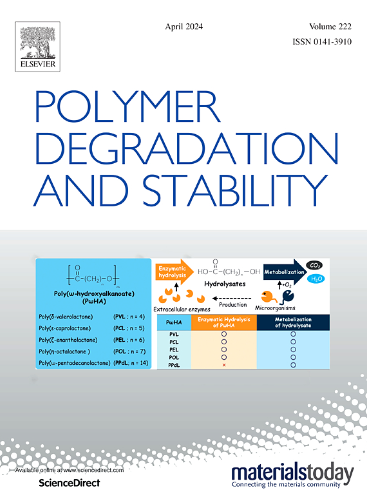Zinc oxide nanoparticles and sage (Salvia officinalis) essential oil as active components of alginate films for food packaging
IF 6.3
2区 化学
Q1 POLYMER SCIENCE
引用次数: 0
Abstract
Antioxidant and antibacterial packaging based on natural polymers have been the subject of interest in recent years. Such functional materials aim to prolong food's shelf life and reduce food waste. Therefore, alginate films enriched with zinc oxide nanoparticles (ZnONPs) and sage essential oil (SEO) were obtained. ZnONPs were produced by means of green synthesis using tansy (Tanacetum vulgare) extract. XRD and SEM results proved the formation of inorganic nanoparticles, whose sizes were about 16 nm and shape was oval. The structure, mechanical properties, moisture content, water vapor transmission rate, and antimicrobial and antioxidant properties of the biopolymeric films with ZnONPs and/or SEO were investigated. ATR-FTIR spectra showed a lack of interactions between polymeric film components. SEM images exhibited uniform distribution of ZnONPs in the alginate film, while SEO formed an emulsion with this biopolymer. Alginate film with both additives exhibited higher values of tensile strength (7.76 ± 0.75 MPa) and elongation at the break (64.98 ± 2.27 %), lower moisture content (19.61 ± 0.20 %), better barrier properties (257.50 ± 4 g•m‒2•day‒1), and enhanced antioxidant (91.64 ± 3.62 μmol Trolox/100 g) and antibacterial properties compared to alginate films with ZnONPs or SEO separately. Combining ZnONPs and SEO was advantageous due to the meaningful synergistic effect, which is especially pronounced in the enhanced antioxidant and antimicrobial features. Such properties are highly needed in the case of active food packaging. Improved properties of the modified alginate film made it suitable for packing applications for fruits and vegetables.
食品包装用海藻酸盐薄膜的活性成分氧化锌纳米颗粒和鼠尾草精油
近年来,基于天然聚合物的抗氧化和抗菌包装一直是人们感兴趣的主题。这些功能材料旨在延长食品的保质期,减少食品浪费。因此,得到了富含氧化锌纳米粒子(ZnONPs)和鼠尾草精油(SEO)的海藻酸盐膜。采用绿色合成的方法,以三色堇(Tanacetum vulgare)提取物为原料制备了ZnONPs。XRD和SEM结果证实了无机纳米颗粒的形成,其尺寸约为16 nm,形状为椭圆形。研究了ZnONPs和/或SEO生物聚合物膜的结构、力学性能、含水率、水蒸气透过率以及抗菌和抗氧化性能。ATR-FTIR光谱显示聚合物膜组分之间缺乏相互作用。SEM图像显示ZnONPs在海藻酸盐膜中均匀分布,而SEO则与该生物聚合物形成乳液。与单独添加ZnONPs或SEO的海藻酸盐膜相比,添加ZnONPs或SEO的海藻酸盐膜具有更高的抗拉强度(7.76±0.75 MPa)和断裂伸长率(64.98±2.27%),更低的含水率(19.61±0.20%),更好的阻隔性能(257.50±4 g•m-2•day-1),增强的抗氧化性能(91.64±3.62 μmol Trolox/100 g)和抗菌性能。ZnONPs与SEO的结合具有显著的协同效应,特别是在抗氧化和抗菌特性上的增强。在活性食品包装的情况下,这些特性是非常需要的。改性后的海藻酸盐薄膜性能得到改善,适用于水果和蔬菜的包装。
本文章由计算机程序翻译,如有差异,请以英文原文为准。
求助全文
约1分钟内获得全文
求助全文
来源期刊

Polymer Degradation and Stability
化学-高分子科学
CiteScore
10.10
自引率
10.20%
发文量
325
审稿时长
23 days
期刊介绍:
Polymer Degradation and Stability deals with the degradation reactions and their control which are a major preoccupation of practitioners of the many and diverse aspects of modern polymer technology.
Deteriorative reactions occur during processing, when polymers are subjected to heat, oxygen and mechanical stress, and during the useful life of the materials when oxygen and sunlight are the most important degradative agencies. In more specialised applications, degradation may be induced by high energy radiation, ozone, atmospheric pollutants, mechanical stress, biological action, hydrolysis and many other influences. The mechanisms of these reactions and stabilisation processes must be understood if the technology and application of polymers are to continue to advance. The reporting of investigations of this kind is therefore a major function of this journal.
However there are also new developments in polymer technology in which degradation processes find positive applications. For example, photodegradable plastics are now available, the recycling of polymeric products will become increasingly important, degradation and combustion studies are involved in the definition of the fire hazards which are associated with polymeric materials and the microelectronics industry is vitally dependent upon polymer degradation in the manufacture of its circuitry. Polymer properties may also be improved by processes like curing and grafting, the chemistry of which can be closely related to that which causes physical deterioration in other circumstances.
 求助内容:
求助内容: 应助结果提醒方式:
应助结果提醒方式:


